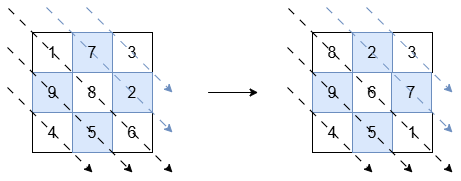3446. Sort Matrix by Diagonals
3446. Sort Matrix by Diagonals
Description
You are given an n x n square matrix of integers grid. Return the matrix such that:
- The diagonals in the bottom-left triangle (including the middle diagonal) are sorted in non-increasing order .
- The diagonals in the top-right triangle are sorted in non-decreasing order .
Example 1:
1 | Input: grid = [[1,7,3],[9,8,2],[4,5,6]] |
Explanation:

The diagonals with a black arrow (bottom-left triangle) should be sorted in non-increasing order:
[1, 8, 6]becomes[8, 6, 1].[9, 5]and[4]remain unchanged.
The diagonals with a blue arrow (top-right triangle) should be sorted in non-decreasing order:
[7, 2]becomes[2, 7].[3]remains unchanged.
Example 2:
1 | Input: grid = [[0,1],[1,2]] |
Explanation:

The diagonals with a black arrow must be non-increasing, so [0, 2] is changed to [2, 0]. The other diagonals are already in the correct order.
Example 3:
1 | Input: grid = [[1]] |
Explanation:
Diagonals with exactly one element are already in order, so no changes are needed.
Constraints:
grid.length == grid[i].length == n1 <= n <= 10-10^5 <= grid[i][j] <= 10^5
Hints/Notes
- 2025/02/23 Q1
- sort
- 0x3F’s solution
- Weekly Contest 436
Solution
Language: C++
1 | class Solution { |